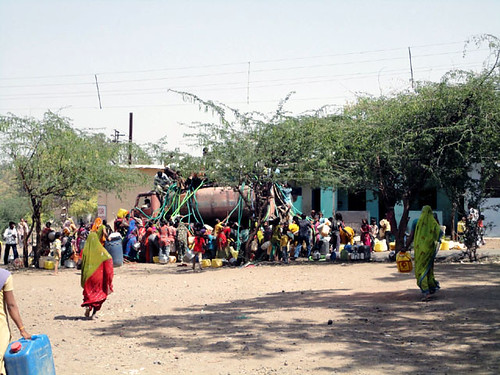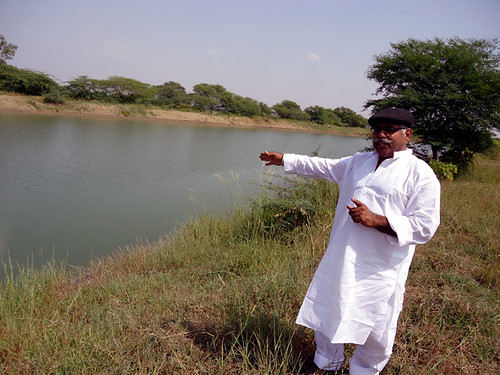How farm ponds saved Dewas from ruin
Why Dewas has the answer to India’s water crisis
Dewas: Revival of groundwater through hard work
By Siraj Kesar, Minakshi Arora
Dewas is the abode of two goddesses: Maa Chamunda and Maa Tulja. Established by Shivaji's General Sabu Singh Pawaj in 17th century, this town also finds mention in ‘Prithviraj Raso’, an epic poem written by Chand Bardai in praise of Prithviraj Chauhan. It was on his way from Ujjain to Delhi that Chauhan’s army had camped here. Much before independence, Dewas was a capital of two princely states. Till the end of the 18th century the Dewas Badi Paanti State and Dewas Chotti Paanti State developed several ponds, wells and stepwells in the town to serve its population. Maharani Yamuna Bai also formed an organisation to sustain the work related to water. The organisation also supported people who wanted to dig wells, construct step wells or develop ponds. Meetha pond, Mendaki pond and Mukta Sarovar besides thousands of wells and stepwells are manifestations of this beautiful collaboration between royalty and society.
Much before independence, Dewas was a capital of two princely states. Till the end of the 18th century the Dewas Badi Paanti State and Dewas Chotti Paanti State developed several ponds, wells and stepwells in the town to serve its population. Maharani Yamuna Bai also formed an organisation to sustain the work related to water. The organisation also supported people who wanted to dig wells, construct step wells or develop ponds. Meetha pond, Mendaki pond and Mukta Sarovar besides thousands of wells and stepwells are manifestations of this beautiful collaboration between royalty and society.
When the British took over the rule, they snatched the ownership of community over ponds and water management and made it part of governance. This was to erase the memories of good work and demoralise the society. The end was tragic.
‘Aaj Bhi Khare Hain Talaab’, the famous work of Mr Anupam Mishra published in 1993, mentions: “The tale of Dewas town neighbouring Indore is stranger. In last 30 years, all its small and big ponds were filled up to construct houses and factories. But then it dawned upon the planners that there’s no water source left. Newspapers started publishing reports of distress migration. Water was required for the town but from where would that come? Instead of focussing on ponds and wells, all efforts were concentrated at Dewas railway station for 10 days. On April 25, 1990, a train arrived from Indore with 50 water tankers. The Minister for Local Governance welcomed the train amidst drum beats. The minister inaugurated the scheme by drinking the water of ‘Narmada’ that had arrived at the station. Earlier too we had examples of water transportation through trains in towns of Gujarat and Tamil Nadu in times of distress. But Dewas now gets this ‘water train’ every morning. The water from these tankers is lifted to the overhead tanks and distributed in the town.”
Nowadays the routine of ‘water trains’ has stopped, but the water is still coming from a distance of 100-150 km through pipelines. The Mandaleshwar dam in Khandwa-Khargon, Nemawar and Lakhundar dam of Shajapur are quenching the thirst of Dewas. Beyond the town, no government thought about the water supply for 1,067 villages of the Dewas district which were situated far from railway lines and pipelines.
Beyond the town, no government thought about the water supply for 1,067 villages of the Dewas district which were situated far from railway lines and pipelines.
When the English rule ended in India, the Anglicized rule took over and promoted tubewell technology in rural areas. Everyone termed tubewell as the best alternative for modern farming. Starting 1960s, loans and other facilities were made available at large scale for mining groundwater through tubewells and high capacity motors. Dewas and surrounding areas were also not left untouched by this trend.
Today, some of the villages of this region have 500-1,000 tubewells. The Ismail Khedi village of Dewas district has around 1,000 tubewells. Many farmers have 10-25 tubewells each. This helped with water availability and 1975-85 period saw some growth in crop production as well. But in around two decades, the groundwater table started receding, plummeting from 60-70 feet to 300-400 feet. As the times changed and inflation soared, tubewells became a very costly affair. Deeper the tubewell, greater the debt farmer fell into.
Those who used to fetch groundwater using Persian Wheel or Bucket Wheel were burdened by the weight of tubewells. Even tubewells started yielding less water due to continuous extraction. A 7 inch pipe would yield only a 1 inch jet, which was not enough even for drinking purposes. Fetching water from deeper aquifer also led to geological contamination which affected the farm land. As a result, farmers started doing less of farming and more of land selling in 1980-90. Many left the villages in search of water. “If you want to take revenge from someone, get a tubewell dug on his farm. His land will turn infertile and he will be ruined,” says Raghunath Singh Tomar of Harnawada village in Tonk Khurd tehsil. Raghunath Singh has 90 acre farm but till the year 2005, his financial situation was very poor. Farming was turning into a loss making occupation due to lack of timely irrigation. Raghunath Singh knew he had to ensure water availability and that can be done only through a farm pond. He asked his brother for help, but instead got a sermon on how digging a pond is impractical and waste of time.
“If you want to take revenge from someone, get a tubewell dug on his farm. His land will turn infertile and he will be ruined,” says Raghunath Singh Tomar of Harnawada village in Tonk Khurd tehsil. Raghunath Singh has 90 acre farm but till the year 2005, his financial situation was very poor. Farming was turning into a loss making occupation due to lack of timely irrigation. Raghunath Singh knew he had to ensure water availability and that can be done only through a farm pond. He asked his brother for help, but instead got a sermon on how digging a pond is impractical and waste of time.
But that did not perturb Raghunath Singh. He dug a 10 feet deep pond on a hectare of land, all by himself. The pond helped irrigate a 15 bigha farm yielding 350 kg per hectare of grams, a much higher figure than the usual 150 kg production. This got him a profit of Rs 1 lakh. The pond had cost only Rs 52,000 but doubled his earnings. This new economics made many, including Raghunath Singh’s brother, realise the benefits of a farm pond. The man had given his village something to emulate.
Inspired by Raghunath Singh, farmers in neighbouring villages also started digging ponds in 2005. This was the moment which changed the fate of Dewas. By now, tubewell was of no use for Raghunath Singh as farm pond had taken over the irrigation. So after one year, he celebrated the pond’s birthday and performed last rites of the tubewell.
Around that time, the District Collector called a large meeting of farmers with an aim to chalk out policies to deal with the prevailing water crisis. Raghunath Singh Tomar shared his experience with the Collector at the event. The Collector realised that there’s no government plan to offer monetary assistance to farmers for digging ponds. Neither were banks ready to support them. On hearing District Collector’s concerns, the Agriculture Department decided to help the farmers.
Mr Mohammad Abbas of the Agriculture Department at Dewas prepared a list of around 7,000 big farmers who owned tractors to develop farm ponds. They were approached and sensitized about farm ponds. The campaign was rightly called ‘Bhagirath Abhiyaan’, inspired by the tale of King Bhagirath who got River Ganga from heavens to earth. The farmers who were digging ponds were called ‘Bhagirath Krishak’ and the ponds were called ‘Rewa Sagar’. With development of these ponds, the farmers started reaping both rabi and kharif crops and no farm land was left fallow.
These farmers also started sharing their experiences in farmers’ meets and travelled to other villages on their own expense to involve more of their contemporaries in the campaign. Farm ponds became the key to prosperity. Now with more than 6,000 farm ponds, the farmers of this region have redefined self-reliance.
The old timers of Harnawada village say that nobody thought about revival of ponds for many years. The introduction of tubewells further stoked the fire and farmers started taking loans to get the tubewells. Raghunath Singh also had tubewells installed at various places on his farm for 25 years. But from the time he got a pond, people realised the benefits and emulated him.
People themselves developed around 1,700 ponds. Inspired by their enthusiasm, the government came up with ‘Balram Talaab’ scheme, which created around 4,000 more ponds. Under this scheme, farmers got assistance of Rs 80,000 to Rs 1 lakh per pond.
These ponds have also raised the water table thus recharging the tubewells of small and medium farmers who could not develop ponds of their own.
Today, Dhaturia village in Tonk Khurd tehsil has 300 families and 150 ponds. All these ponds were built in the year 2006. Most of these farmers at that time were under debt due to water shortage but with ponds, the crop production improved and within two years they were able to repay the loans. It’s not the story of just one village. The whole district has got a makeover.
Now farmers grow pulses, soya and other grains in first crop season. Second season gets them gram and Chandausi variety of wheat besides potato, onion and chilli etc. Chandausi is a traditional variety of wheat famous for its nutritional values. The ponds have also helped with dairy production. Earlier, farmers used to buy fodder for livestock, now they grow green fodder on their own farm and also sell the surplus. The better availability of green fodder has increased milk production. The number of cows has soared proportionally to rise in number of farm ponds. Bhairvaan Khedi village has 70 families with very small farms. The main occupation of villagers is milk production which is sustained by 18 ponds.
Around 150 villages of the district have more than 100 ponds. Dhaturiya village has the maximum 165 ponds followed by Gorwa which has 150 ponds. Tonk Kala has 132 ponds while Harnawada, Lasudaliya, Brahman, Chidawad and Jirway have over 100 ponds. In terms of area, Kharda village is known to have the biggest ponds extending upto 8-10 acres.
These villages have gained national and international repute with several organisations visiting these to learn about the positive change. From 200-400 feet, the water table of Dewas rural area has risen to 30-40 feet. This good work has also impacted the town positively. From 300 feet at one time, the water table in the urban area has now gone up to 170 feet. If government and society continue to do this good work, the mistakes of last 40-50 years can be easily rectified in a couple of years.
Mr Siraj Kesar is editor of Hindi Water Portal
Ms Minakshi Arora is associated with the ‘Water Keeper Alliance’













